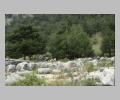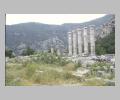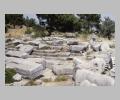| Context: | Priene |
| Type: | Altar |
| Summary: | Rectangular altar located 12.35 m. east of the Temple of Athena, on axis with the temple. |
| Date: | ca. 325 BC |
| Dimensions: | Schrader's reconstruction of the altar produced the following measurements: length of altar: 13.20 m.; width of altar: 7.12 m.; est. height: ca. 3.00 m.; height of podium blocks: 0.86 m.; est. height of half-columns (incl. base and capital) 2.70 m. The height of the best-preserved relief slabs is 1.30 m. and 1.31 m. |
| Region: | Ionia |
| Period: | Hellenistic |
Architectural Order:
Ionic pilasters are reconstructed on the sides of the altar, although there is no unambiguous evidence for this architectural feature.
Plan:
A low, rectangular altar standing on two steps; its sides were probably decorated with half-column pilasters between which are a series of low podia, supporting twenty relief panels. In the relief panels were carved draped female figures, almost certainly Muses, and a figure of Apollo Kitharoidos. The columns supported an entablature consisting of an architrave crowned by an ovolo and dentil, with cornice course of Ionic geison with ovolo crown, and finally a cyma recta. The relief panels and columns essentially formed a screen wall around the three sides of the altar platform on which the sacrifices took place.
Date Description:
Style of relief sculpture: the pose of the seated Muse now in Istanbul is thought to be derived from an earlier, seated female prototype, either a Muse (Ourania) or a Tyche figure. If a Tyche figure provided the inspiration for the pose, the altar reliefs must post-date ca. 300 B.C. (undisputed date of creation of Tyche figure). Others argue that the style of the standing female figure from the altar, now in Berlin, cannot be earlier than ca. 180 B.C. The style of the shoes worn by the relief figures has also been used as a dating device, with parallels cited in the late third century B.C.
History:
The history of the altar is difficult to reconstruct with certainty. The dating of the sculptures, based on stylistic considerations, has resulted in dates ranging from the late third century to the mid-second century B.C. There is general agreement that the altar is of later date than the temple itself, and the most recent analysis suggests that the altar reliefs were carved in the late third century B.C. The architectural style of the altar itself, however, is consistent with an earlier date, in the second half of the fourth century, leading some to conclude that the altar was planned at this time, but not actually executed until later. When the temple was rededicated to Athena and Augustus in the late first century B.C., this rededication was also recorded on the architrave of the altar.
Other Notes:
The altar was first discovered by Pullan and briefly described in his Antiquities of Ionia, IV (1881). The reconstruction of the altar as low and rectangular in form was first suggested by Schrader (1904); this reconstruction was challenged by Dörpfeld and von Gerkan (1924), who viewed the altar as similar in plan to the Great Altar at Pergamon. By analogy with the Pergamon monument, the Priene altar was thus dated to some time after the mid-second century B.C. Recent analysis of Pullan's excavation notes and photographs, and the discovery of additional relief fragments, has led Carter (1983) to confirm Schrader's initial reconstruction of the monument as a low altar. The Pergamon analogy is thus erroneous, and the style of the reliefs may also suggest an earlier date, that is, in the last quarter of the third century B.C.
Sources Used:





